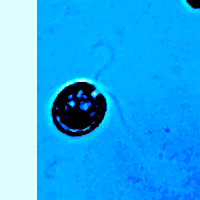Tracking flagella undulations in microscopy images
Autumn 2014
Master Semester Project
Project: 00274

Flagella are lash-like appendage that protrudes from the cell body of certain cells. The primary role of a flagellum is usually locomotion, but it also often has sensory functions thanks to its sensitivity to chemicals and temperatures in the outside environment. In many biomedical studies, it is therefore of crucial importance to be able to quantify and analyse the motion of flagella under different conditions. Cellular bodies and flagella anchors are usually easy to detect, but the flagella themselves tend to appear fainter at increasing distance from the anchor. The goal of this project is to develop a tracking algorithm to analyse the undulations of flagella. We suggest to design a spatio-temporal strategy relying on steerable filters. We propose to work on two datasets involving different organisms, namely plankton chlamydomonas and spermatozoids. As these organisms evolve in a fluid environment with known properties, fluid mechanics models could also be used in order to refine the analysis. The approach will ultimately be implemented as an ImageJ/ICY plugin freely available to the biology research community.
- Supervisors
- Daniel Sage, daniel.sage@epfl.ch, 021 693 51 89, BM 4.135
- Michael Unser, michael.unser@epfl.ch, 021 693 51 75, BM 4.136
- Daniel Sage, daniel.sage@epfl.ch, BM 4.135, Tel: 021 693 51 89